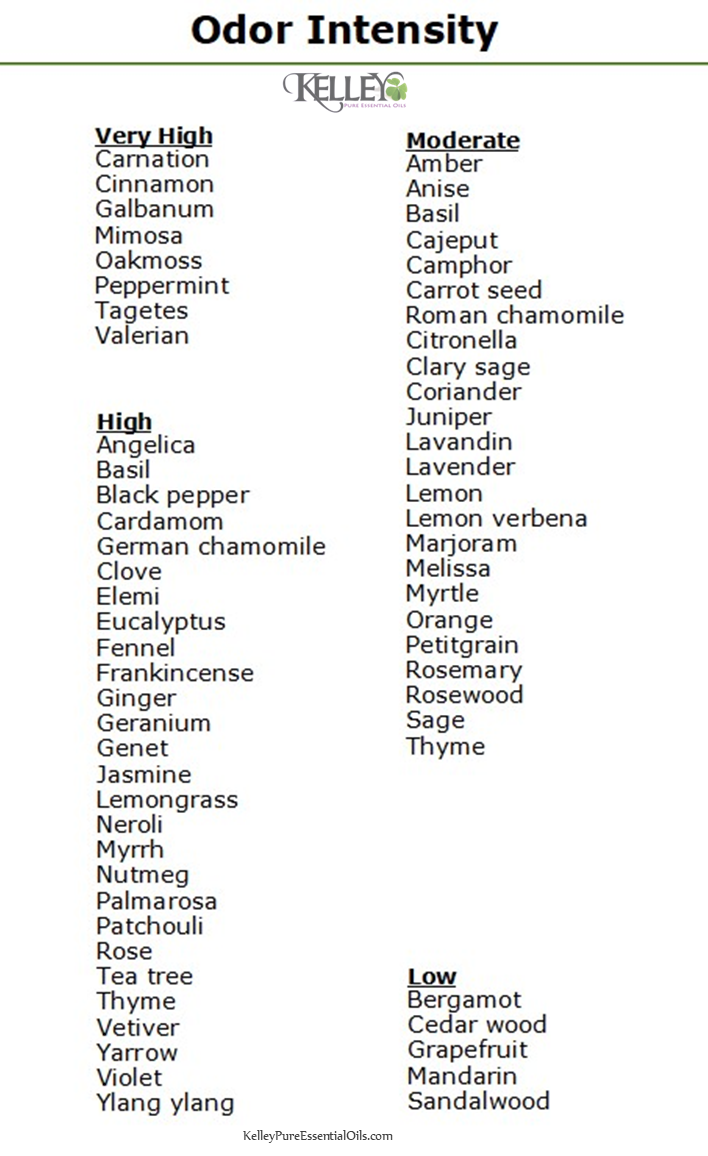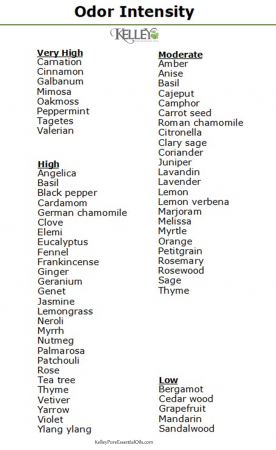More info
When essential oils are blended, it is always worth keeping the fragrance in mind. It is more pleasing to use a remedy that has a pleasant odor for the individual concerned. Some essential oil fragrances can be quite incompatible.
Blending is an important aspect of aromatherapy. It allows one to use the most appropriate essential oils in an aromatherapy treatment.
Balancing
Perfumers have developed analytical techniques for determining the odor intensity. The odor intensities presented below are obtained for appeal and are rated on a scale from 1 to 10. Often the odor intensity may be used as a guide to blending. The key to balance is to achieve olfactory equilibrium which occurs when two or more essential oils are in a mixture and no single essential oils dominates the odor of the blend.
For example: if making a blend of frankincense and lavender, the respective odor intensities are 7 and 5. This means that the frankincense odor is stronger than that of lavender. As a result, mixing one drop of frankincense and one drop of lavender does not produce a fragrance representing both essential oils. Frankincense would dominate. To create a blend which can be perceived as a balanced combination of both essential oils it may be necessary to mix one drop of Frankincense to 3 drops of lavender (or even more).

References:
Battaglia, S. The Complete Guide to Aromatherapy; Third Edition The International Centre of Holistic Aromatherapy, Australia, 2017
Tisserand R. Young R. Essential Oil Safety, second edition. Churchhill Livingstone, UK, 2013
Sheppard-Hanger S. The Aromatherapy Practitioner Reference Manual. Atlantic Institute of Aromatherapy, USA, 2000
Caddy R. Essential Oils in Colour. Amberwood Publishing, UK, 2005
Lawless J. The encyclopedia of Essential Oils. Element Books Limited, GB, 1992
Caddy R. the Essential Blending Guide. Amberwood Publishing, UK, 2007
Weaver W.W. Sauer’s Herbal Cures. Routledge, UK, 2001
World Wide Web Encyclopedia Britannica. USA, 2014
Photos attribution – istock Photos
LabAroma.com
AromaWeb.com
Safety Considerations:
Do not take essential oils internally.
Do not apply to eyes, sensitive areas or mucous membranes.
Do not apply undiluted to skin (for directions on proper dilution refer to an aromatherapy text).
The information on this website is not intended to diagnose or prescribe.
Pregnant women, nursing mothers and children should not use essential oils without first consulting a healthcare provider.
The statements on this website have not been evaluated by the FDA.
You should not use this information for treating a health problem or disease or to make a self-diagnosis.
Contact your Health Care provider immediately if you suspect that you have a medical problem.
Information and statements regarding Kelley products have not been evaluated by the FDA and are not intended to diagnose, treat, cure, or prevent any health condition or disease. All information, content and product descriptions contained within this site is for reference purposes and is not intended to substitute advice given by a pharmacist, physician, or other licensed health-care professional. You should not use this information for treating a health problem or disease or to make a self-diagnosis. Contact your Health Care provider immediately if you suspect that you have a medical problem.







